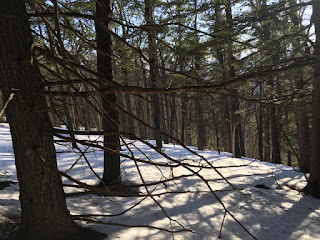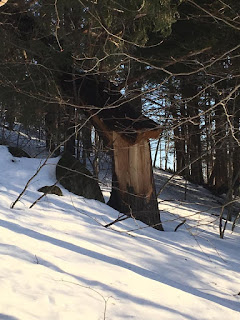The boring cousin of the ski is what we now think of as a snowshoe. But the skiers of the 19th Century called their skis snowshoes. In written accounts of the time, you will see that term. Fridtjof Nansen used it in Farthest North when referring to the skis used by the expedition. Skis and snowshoes are answers to the same basic need: traveling in a snow-covered landscape with the least effort required.
Least effort may seem like an inappropriate term when bulldozing up a steep slope with either device on your feet. And the device we now call snowshoes never gives you the dividend of glide. You pick them up and put them down.
When the trail was the road, the winter trail would be packed by all of the travelers using it, from the buildup of the snow pack, through the heart of winter, all the way to the thaw. The thaw would isolate people much more than winter did, because travel would be exhaustingly slow or outright impossible as the winter's accumulation turned to a mire of granular soup. But during the heart of winter a traveler could branch out onto lesser-used trails, or through areas with no trail, using the versatile human-enhancing devices common in their culture. Later, when the ski had been introduced to many areas outside of its native range, it was added to the available toolkit. By then, of course, the Industrial Age was advancing, and travel by machine was becoming more and more of an option. But the initial diaspora happened early enough to make skis a practical part of life in areas without developed road systems.
All that was a long time ago. Almost no one now needs to depend on skis to get around. It's a lifestyle choice. You might manage to build yourself a life in which the ski becomes a necessary, practical tool, but only because you chose to go that way. For the rest of us, it's a matter of aesthetics. But that can cover a wide range of considerations.
Exercise is good. Exercises that demand a degree of coordination help to keep those parts of the brain engaged. One way to maintain balance is to use your balance. But long before one needs to think of the geriatric aspects of skiing it also offers unmatched versatility in dealing with a wide range of snow conditions.
Let's talk first about where it doesn't work well at all. Ice is the nemesis of skis. You can get ski crampons, but they're not as effective as a snowshoe with teeth on the bottom at dealing with crusty snow and ice. If you found yourself facing a limited area of iciness, or you had to extricate yourself from the wilderness after an ice storm blighted your multi-day backcountry ski tour, you would have to figure out how to use whatever tools you have at the time: metal edges, ski crampons, alternate footwear. It's all a matter of what you want to plan and carry tools to deal with.
The deeper and softer the snow, the larger the "boat" you need to float on it. You may be floating pretty low in it, on skis or snowshoes. But a touring ski is designed to plane upwards, whereas a snowshoe has to be lifted and set down in a more deliberate fashion.
All winter travelers in the human-powered era would look for conditions that were firm and fast. Even in a modern world, recreational snow travelers prefer to have a trail that has been packed and smoothed. This opens the door for such totally grooming-dependent users as fat bikes. And for skiers there's such a thing as too hard a trail. A well-used hiking trail that has been through some thaw and freeze transitions can be like undulating porcelain. A $250 set of snowshoes with a crampon, or a $250 set of studded tires on a $2,000 bike might find the going good on the porcelain trail. A ski not so much. Of those users, only the bike would be completely dependent on the trail, though. The ancestral snow devices -- skis and snowshoes -- have the option to bushwhack much more freely than the bike rider can ever consider.
When we got an early winter delivery of about 5 inches of snow here, I went out on my old faithful 200cm long, 60mm wide skis, with my rejuvenated 75mm boots, to slide around the woods. Parts of the state got ridiculous amounts of snow, upwards of two feet in places. Too much at once can be hard to manage, even for people who like snow and might make their living helping people to play on it. Five inches was just enough to cover most of the irregularities on my crudely defined trails. Much of the forest is open enough to make a trail more of a technical formality than a necessity.
The steeper slopes farther up the mountain -- or even at the back of my own patch -- need more snow to make descent controllable. It's never safe. You can move extremely methodically to reduce the risk of a mishap, and find yourself overtaken by darkness because you took so long to get down. This is highly unlikely when the total distance to home is less than 1,000 feet, but becomes a distinct possibility when the slope you can reach higher up has become a complex bushwhack including old-growth forest, steep, rocky slopes, new, large clear cuts, and dense thickets of saplings. Depending on when you start out, you have to watch how much time you expend on each part of the journey. That's true anywhere you go.
If you're unsure of snow conditions where you're going, the conservative choice is the snowshoe. You give up on glide, but you know you'll be able to trudge reliably. If you know that snow conditions will allow for it, and you have the skills and equipment, skis offer you the most freedom. Gliding liberates you from friction. Gravity becomes an asset and a plaything.

















